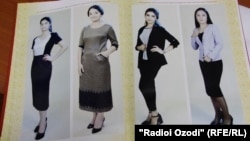What's a Tajik woman to do? She wants to step out, but is unsure if her dress is too long -- or too short. She wants to wear a head scarf, but what type? And it's raining. Does she dare wear galoshes?
She no longer has to make such choices on her own, as Tajikistan's government is now providing a lengthy guide on how female citizens should dress, no matter their age, and whatever the season or occasion.
The 367-page hardback -- titled The Guidebook To Recommended Outfits In Tajikistan -- outlines acceptable garment colors, shapes, lengths, and materials.
While the 11-chapter guide issued by the Culture Ministry is not law, several government agencies have been tasked with overseeing that compliance is enforced. The new guide is for females only, beginning from the age of 7, but officials have made it clear that they are completing a similar guide for men.
Room For Imagination
Both miniskirts and maxi dresses are out, according to the recommendations, which state that hemlines should fall a good 15-20 centimeters below the knee, but also at most 20 centimeters above the ankle.
Sleeves must not be shorter than 10 centimeters, and necklines must not drop more than 15 centimeters in front, and 5 centimeters in the back.
Flat shoes are unacceptable, including the cheap and popular felt loafers known as Irinka shoes. And flip-flops and galoshes definitely out; they have been deemed health hazards, for unstated reasons. It is unclear whether women are supposed to always wear heels in Tajikistan, 93 percent of which is covered by mountains.
A colorful head scarf or kerchief is an option, but it "has to be tied behind the head in the national Tajik style" and it should not cover the face and neck. Black head scarves are banned entirely, even for funerals.
In fact, no black garments are allowed at funerals -- women are advised to wear a blue outfit with a white head scarf. And the guidebook doesn't stop there, laying down rules for dressing for work, national events, weddings and private parties, eating out, going to the theater and concerts, socializing on weekends, and even going for a stroll in the park.
Aside from weddings and funerals, it doesn't dictate what women should wear at home.
Citing health reasons, the guidebook advises that women avoid synthetic materials and stick to cotton, wool, and silk fabrics.
Foreign Not Fashionable
Many of the recommendations are not unfamiliar to Tajik women. The government has long tried to curtail the influence of what it describes as alien culture, as well as outward signs of religious extremism.
Tajikistan has officially banned the wearing of the face-covering Islamic hijab in public places, and has introduced uniforms for students and workers.
For now, only about 300 copies of the guidebook have been distributed to government agencies. But the book, a copy of which was obtained by RFE/RL, is set to be printed in larger quantities for broader distribution.
While no penalties for noncompliance with the guidebook are in place, anything "recommended" by authorities is usually treated as law, and there are signs it is being enforced as such.
In Tajikistan's second city of Khujand, for example, the regional women's committee recently sought to "identify" women whose dress was in violation of the new guidelines.
Muhabbat Davlatova, a resident of the northern district of Ghafurov, was stopped on April 4 and taken to police headquarters for wearing a hijab, which has faced increased restrictions since 2007.
"I have the right to wear what I like," Davlatova told RFE/RL. "But the officials demanded that I tie my head scarf the way they wanted, so I pledged in writing that I would tie my kerchief behind my head."
Muqaddaskhon Shodiboeva, of the Khujand city government, was among the officials behind the raid. "We told Davlatova that we were not demanding that she remove her head scarf," the official told RFE/RL's Tajik Service. "We just officially warned her to tie it in the traditional Tajik style.... I told her that [covering the face and neck] is an alien culture and is not compatible with our customs."
The enforcement of such unofficial dress codes began months before the guidebook was issued. In 2017, Tajik officials claimed that their "explanatory efforts" convinced some 8,000 women to remove their hijabs.
Men In Tracksuits
Tajikistan's previous efforts to control what citizens wear were widely seen as attempts by the secular government to counter the influence of Islam in the predominantly Muslim country.
Critics have said that the measures violate citizens' freedom of choice, and some women have left their jobs and universities to protest the ban on hijabs.
The Interior Ministry last year rejected numerous claims from women who said they were stopped on the street and fined for wearing the hijab.
Men have also received their fair share of warnings and clothing advice from the government.
Authorities have banned the wearing of bushy beards and instructed male students at the nation's only Islamic University to don suits and ties, just like the students at other educational institutions in the country.
Thousands of men have reportedly been stopped by police and had their beards shaven against their will.
Culture Minister Shamsiddin Orumbekzoda recently hinted that a guidebook is in the works for Tajik men, "some of whom show up in tracksuits even for official meetings."
"Soon we'll make it compulsory for men to wear a shirt, suit, and tie," the minister added.















